Lesson2BeijingOpera
- 格式:docx
- 大小:14.45 KB
- 文档页数:2
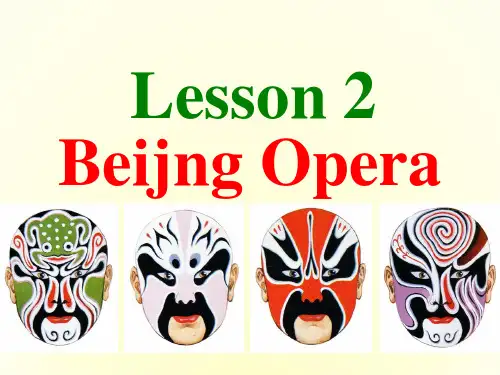

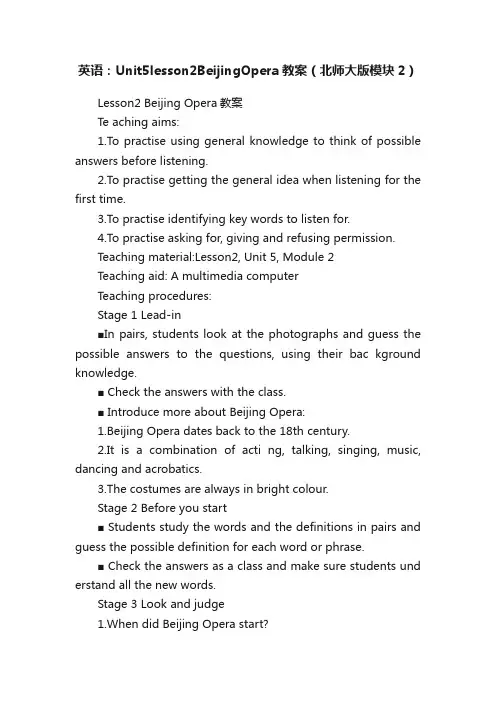
英语:Unit5lesson2BeijingOpera教案(北师大版模块2)Lesson2 Beijing Opera教案Te aching aims:1.To practise using general knowledge to think of possible answers before listening.2.To practise getting the general idea when listening for the first time.3.To practise identifying key words to listen for.4.To practise asking for, giving and refusing permission.Teaching material:Lesson2, Unit 5, Module 2Teaching aid: A multimedia computerTeaching procedures:Stage 1 Lead-in■In pairs, students look at the photographs and guess the possible answers to the questions, using their bac kground knowledge.■ Check the answers with the class.■ Introduce more about Beijing Opera:1.Beijing Opera dates back to the 18th century.2.It is a combination of acti ng, talking, singing, music, dancing and acrobatics.3.The costumes are always in bright colour.Stage 2 Before you start■ Students study the words and the definitions in pairs and guess the possible definition for each word or phrase.■ Check the answers as a class and make sure students und erstand all the new words.Stage 3 Look and judge1.When did Beijing Opera start?2. How many main roles are there in Beijing Opera?3. What are the main instruments played in it?4. Match the main roles with their names:sheng male roles with brightly painted facesdan female rolesjing clown roleschou male rolesStage 4 Find out the definition■ Students study the words an d the definitions in pairs and guess the possible definition for each word or phrase.■ Check the answers as a class and make sure students understand all the new words.Step 5 ListeningUse the Strategies :Listen & answer the questions.1.What skills do Beijing Opera actors need to have?2. Where was Beijing Opera performed at the beginning?3. Why does it ha ve very loud music and a piercing singing style?4. Why do performers wear brightly coloured costumes?Step 6 TapescriptStage7 ReadingRead the last part of the programme and answer the questions:1.What does the stage look like in Beijing Opera?2.How do symbols play an important role in Beijing Opera?Stage 8 Useful ExpressionsStage 9 Listening■ Students lis ten to the dialogue and make notes about Li Ming and Zhu Meiling.。
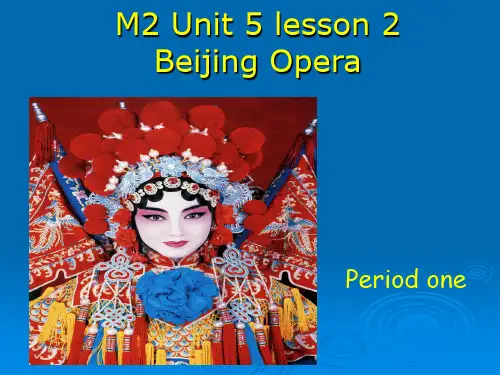
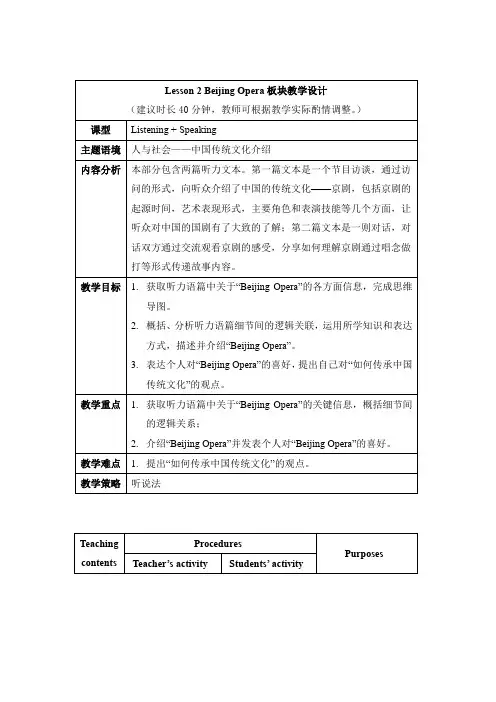
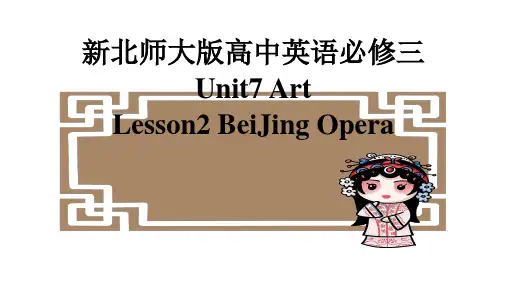
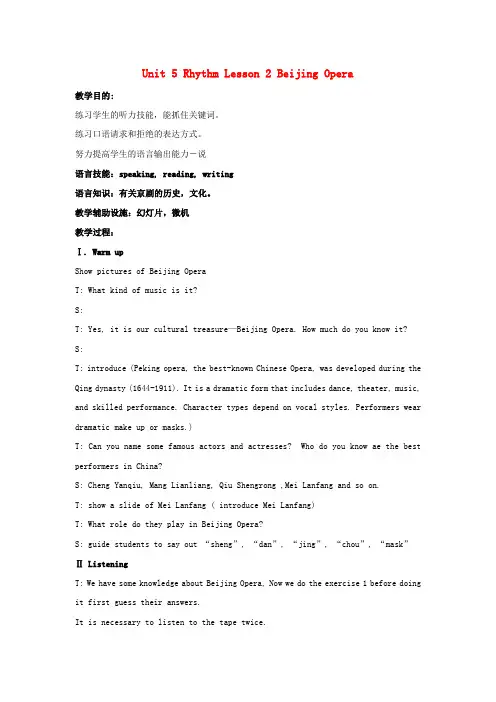
Unit 5 Rhythm Lesson 2 Beijing Opera教学目的:练习学生的听力技能,能抓住关键词。
练习口语请求和拒绝的表达方式。
努力提高学生的语言输出能力-说语言技能:speaking, reading, writing语言知识:有关京剧的历史,文化。
教学辅助设施:幻灯片,微机教学过程:Ⅰ. Warm upShow pictures of Beijing OperaT: What kind of music is it?S:T: Yes, it is our cultural treasure—Beijing Opera. How much do you know it? S:T: introduce (Peking opera, the best-known Chinese Opera, was developed during the Qing dynasty (1644-1911). It is a dramatic form that includes dance, theater, music, and skilled performance. Character types depend on vocal styles. Performers wear dramatic make up or masks.)T: Can you name some famous actors and actresses? Who do you know ae the best performers in China?S: Cheng Yanqiu, Mang Lianliang, Qiu Shengrong ,Mei Lanfang and so on.T: show a slide of Mei Lanfang ( introduce Mei Lanfang)T: What role do they play in Beijing Opera?S: guide students to say out “sheng”, “dan”, “jing”, “chou”, “mask”Ⅱ ListeningT: We have some knowledge about Beijing Opera, Now we do the exercise 1 before doing it first guess their answers.It is necessary to listen to the tape twice.Show students a chart about Beijing Opera’s structureDo the exercise 2 and 3Do the exercise 4Read through the Strategies with the class and see if they know how to use any of these Strategies already.Students listen to the cassette and get the general idea. Play the cassette. Do the exercise 5, 6 and 7The teacher can draw a conclusion:Besides Beijing Opera, there are still other National Treasures in China. They serve as a window of China. And through this window, foreigners are able to understand Chinese culture better.Ⅲ SpeakingPractice your oral EnglishSuppose Smith come from America. He is interested in Beijing Opera. As his interpreter you are introduce Beijing Opera to him. .Do the exercise 9Ⅳ WritingWrite a composition to introduce Beijing Opera its history and value,including Characters, scenes, costumes and skills needed. You can add some details, such as some names of play and famous artists.。
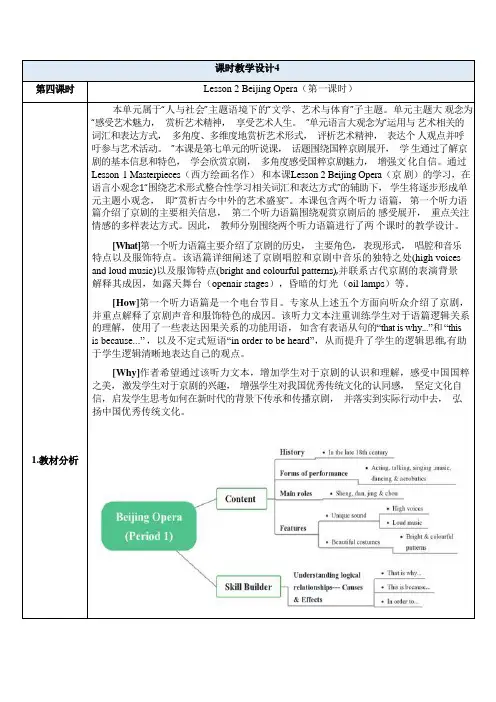
本单元属于“人与社会”主题语境下的“文学、艺术与体育”子主题。
单元主题大观念为“感受艺术魅力,赏析艺术精神,享受艺术人生。
”单元语言大观念为“运用与艺术相关的词汇和表达方式,多角度、多维度地赏析艺术形式,评析艺术精神,表达个人观点并呼吁参与艺术活动。
”本课是第七单元的听说课,话题围绕国粹京剧展开,学生通过了解京剧的基本信息和特色,学会欣赏京剧,多角度感受国粹京剧魅力,增强文化自信。
通过Lesson 1 Masterpieces(西方绘画名作)和本课L esson 2 Beijing Opera(京剧)的学习,在语言小观念1“围绕艺术形式整合性学习相关词汇和表达方式”的辅助下,学生将逐步形成单元主题小观念,即“赏析古今中外的艺术盛宴”。
本课包含两个听力语篇,第一个听力语篇介绍了京剧的主要相关信息,第二个听力语篇围绕观赏京剧后的感受展开,重点关注情感的多样表达方式。
因此,教师分别围绕两个听力语篇进行了两个课时的教学设计。
[What]第一个听力语篇主要介绍了京剧的历史,主要角色,表现形式,唱腔和音乐特点以及服饰特点。
该语篇详细阐述了京剧唱腔和京剧中音乐的独特之处(high voices and loud music)以及服饰特点(bright and colourful patterns),并联系古代京剧的表演背景解释其成因,如露天舞台(openair stages),昏暗的灯光(oil lamps)等。
[How]第一个听力语篇是一个电台节目。
专家从上述五个方面向听众介绍了京剧,并重点解释了京剧声音和服饰特色的成因。
该听力文本注重训练学生对于语篇逻辑关系的理解,使用了一些表达因果关系的功能用语,如含有表语从句的“that is why...”和“thisis because...”,以及不定式短语“in order to be heard”,从而提升了学生的逻辑思维,有助于学生逻辑清晰地表达自己的观点。
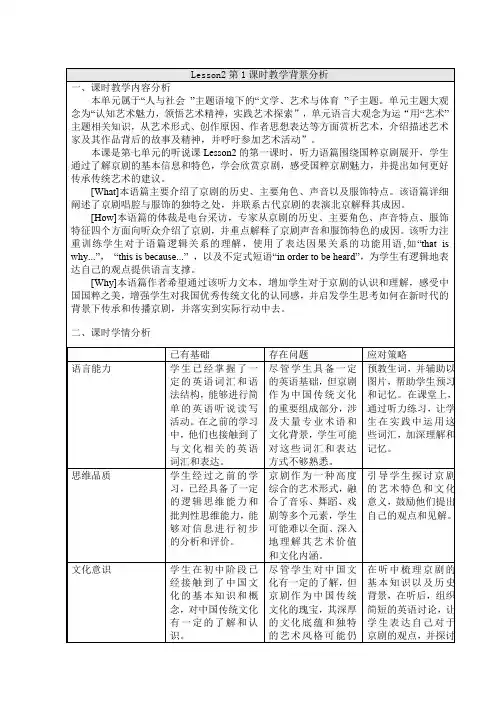
第1课时教学过程
教学目标1 学习活动效果评价预计
时间
获取梳理京剧的基本知识。
Step 1: Activate and share
T shows the four main roles of Beijing Opera and
guide Ss to tell the topic of this lesson: Beijing
Opera.
T creates a situation: Some British high school
students came to our school. They visited the
Beijing Opera club and they wanted to know more
about Beijing Opera from you.
What do you know about Beijing Opera?
学生能够根
据图片说出
本课主题
“Beijing
Opera”
2’
设计意图:
【驱动】激活学生在“京剧”这一主题的背景知识,通过创设真实情境问题,学生认识到自己在内容和语言上的双重不足,激发学生学习兴趣。
Step 2: T shows some pictures and some words that
Ss are unfamiliar with. T guides Ss to match the
words with the pictures.
Ss read after T together.
学生能够读
出生词,并
根据图片猜
出生词含
义,将图片
和单词进行
匹配
3’。
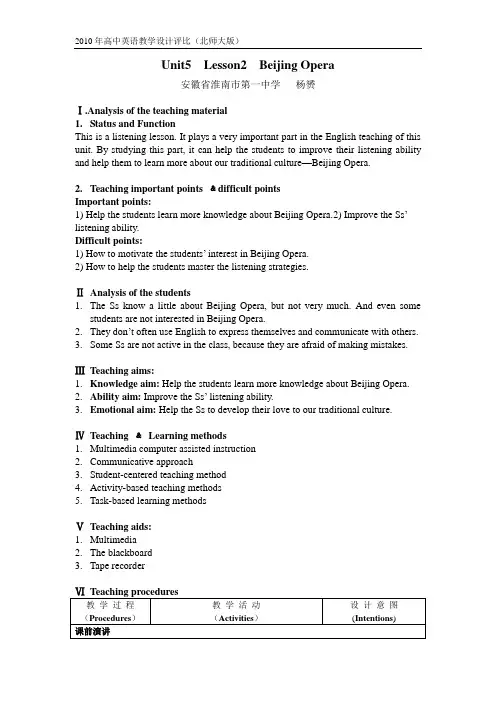
Unit5 Lesson2 Beijing Opera安徽省淮南市第一中学杨赟Ⅰ.Analysis of the teaching material1.Status and FunctionThis is a listening lesson. It plays a very important part in the English teaching of this unit. By studying this part, it can help the students to improve their listening ability and help them to learn more about our traditional culture—Beijing Opera.2.Teaching important points ﹠difficult pointsImportant points:1) Help the students learn more knowledge about Beijing Opera.2) Improve the Ss’listening ability.Difficult points:1) How to motivate the students’ interest in Beijing Opera.2) How to help the students master the listening strategies.ⅡAnalysis of the students1.The Ss know a little about Beijing Opera, but not very much. And even somestudents are not interested in Beijing Opera.2.They don’t often use English to express themselves and communicate with others.3.Some Ss are not active in the class, because they are afraid of making mistakes.ⅢTeaching aims:1.Knowledge aim: Help the students learn more knowledge about Beijing Opera.2.Ability aim: Improve the Ss’ listening ability.3.Emotional aim: Help the Ss to develop their love to our traditional culture.ⅣTeaching ﹠Learning methods1.Multimedia computer assisted instructionmunicative approach3.Student-centered teaching method4.Activity-based teaching methods5.Task-based learning methodsⅤTeaching aids:1.Multimedia2.The blackboard3.Tape recorderⅦ Blackboard designUnit5 Lesson2 Beijing OperaHistory Main rolesMain instrumentsBeijing Opera SymbolsSkillsSinging styles Costumes。
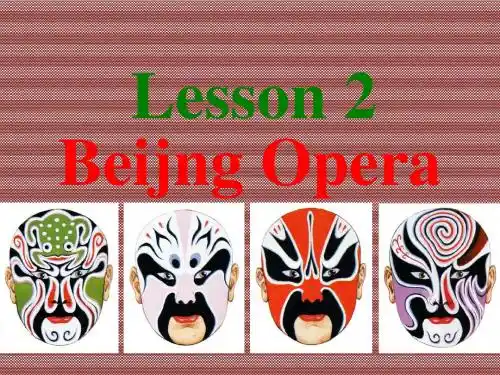
Lesson2 Beijing Opera教案Teaching aims:1.To practise using general knowledge to think of possible answers before listening.2.To practise getting the general idea when listening for the first time.3.To practise identifying key words to listen for.4.To practise asking for, giving and refusing permission.Teaching material:Lesson2, Unit 5, Module 2Teaching aid: A multimedia computerTeaching procedures:Stage 1 Lead-in■ In pairs, students look at the photographs and guess the possible answers to the questions, using their background knowledge.■ Check the answers with the class.■ Introduce more about Beijing Opera:1.Beijing Opera dates back to the 18th century.2.It is a combination of acting, talking, singing, music, dancing and acrobatics.3.The costumes are always in bright colour.Stage 2 Before you start■ Students study the words and the definitions in pairs and guess the possible definition for each word or phrase.■ Check the answers as a class and make sure students understand all the new words.Stage 3 Look and judge1.When did Beijing Opera start?2. How many main roles are there in Beijing Opera?3. What are the main instruments played in it?4. Match the main roles with their names:sheng male roles with brightly painted facesdan female rolesjing clown roleschou male rolesStage 4 Find out the definition■ Students study the words and the definitions in pairs and guess the possible definition for each word or phrase.■ Check the answers as a class and make sure students understand all the new words.Step 5 ListeningUse the Strategies :Listen & answer the questions.1.What skills do Beijing Opera actors need to have?2. Where was Beijing Opera performed at the beginning?3. Why does it have very loud music and a piercing singing style?4. Why do performers wear brightly coloured costumes?Step 6 TapescriptStage 7 ReadingRead the last part of the programme and answer the questions:1.What does the stage look like in Beijing Opera?2.How do symbols play an important role in Beijing Opera?Stage 8 Useful ExpressionsStage 9 Listening■ Students listen to the dialogue and make notes about Li Ming and Zhu Meiling. ■ Play the dialogue two or three times if necessary.■ Students can compare answers in pairs before checking answers as a class.Step 10 Function FileStep 11 SummaryStage 12 AssignmentHave you ever seen any shows? Write a passage to describe one unforgettable show you have ever seen.。
Unit 5Lesson 2 Beijing OperaTeaching aims:To practice using general knowledge to think of possible answers before listeningTo practice getting the general idea when listening for the first timeTo practice identifying key words to listen forTo practice asking for, giving and refusing permissionTeaching difficultiesTo practice asking for, giving and refusing permissionTo practice identifying key words to listen forTeaching Aids: computer and cassetteTeaching procedures:Ⅰ. Warming upFirst listen to a piece of Beijing OperaT: What kind of music is it?S:T: Yes, it is our cultural treasure—Beijing Opera. What do you think of Beijing Opera? Who can sing a piece of Beijing Opera for us?S:T: Thank you for your wonderful performance. How much do you know about it?S:T: Peking opera, the best-known Chinese Opera, was developed during the Qing dynasty (1644-1911). It is a dramatic form that includes dance, theater, music, and skilled performance. Character types depend on vocal styles. Performers wear dramatic make up or masks.T: Can you name some famous actors and actress? Who do you know is the best performer in China?S: Cheng Yanqiu, Mang Lianliang, Qiu Shengrong and so on. Mei Lanfang.T: show a slide of Mei Lanfang ( introduce Mei Lanfang)T: What role do they play in Beijing Opera?S: guide students to say out “sheng”, “dan”, “jing”, “chou”, “mask”ⅡListeningT: We have some knowledge about Beijing Opera, Now look at these exercise and give a judge firstly then listen to the cassette and check your guess.Do the exercise 1Show students a chart about Beijing Opera’s structureDo the exercise 2 and 3Do the exercise 4Read through the Strategies with the class and see if they know how to use any of these Strategies already.Students listen to the cassette and get the general idea. Play the cassette without pausing the first time. And ask them to answer the questions.Do the exercise 5, 6 and 7The teacher can draw a conclusion:Besides Beijing Opera, there are still other National Treasures in China. They serve as a window of China. And through this window, foreigners are able to understand Chinese culture better.ⅢSpeakingDo the exercise 8.Imagine you have to ask for permission in the situations below. Think of good reasons.Practice your oral EnglishSuppose Smith come from America. He is interested in Beijing Opera. As his interpreter you are introduce Beijing Opera to him. .Do the exercise 9ⅣWritingWrite a composition to introduce Beijing Opera its history and value,including Characters, scenes, costumes and skills needed. You can add some details,such as some names of play and famous artists.。
Beijing Opera Revision Handout
I.Making sentences.
1、京剧有四个主要角色,他们是生、旦、净、丑。
(用定语从句)
________________________________________________________________________________ ________________________________________________________________________________ 2、京剧结合了表演、对话、唱歌、音乐、舞蹈和杂技。
________________________________________________________________________________ ________________________________________________________________________________ 3、音乐声音必须要大,演员嗓音一定要尖锐,这样才能让观众听到。
________________________________________________________________________________ ________________________________________________________________________________ ________________________________________________________________________________ 4、京剧演员的戏服颜色鲜艳,这样观众们在室外露天舞台才能看得更清楚。
________________________________________________________________________________ ________________________________________________________________________________ ________________________________________________________________________________
这座奖杯(trophy)是我们团结的象征。
________________________________________________________________________________ 我很荣幸能够代表我们班参加这次比赛。
________________________________________________________________________________ III.Read and reply the letter.
Dear my Chinese friend,
How are you?
I’m learning Chinese recently and my teacher told us something about Beijing Opera. I’m very interested in it. Could you tell me more about it? And can you take me to watch a live performance when I come to Beijing next month?
Thank you very much! Looking forward to hearing from you.
Best wishes.
Yours,
Linda。